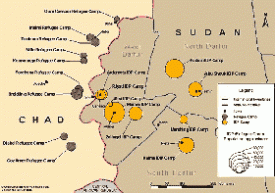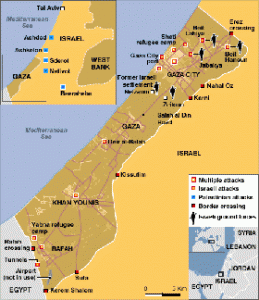

What Works
The best thing about the map of the camps around Darfur is that it exists at all. After looking at some of the elaborate maps that have been part of the news coverage of Gaza (see the one here, click through on the caption for a larger image) and earlier, of the bombings in Mumbai, I assumed I would be able to find something of similar quality related to the camps around Darfur to sate my curiosity about how big the camps are, where they are, how they are supplied, whether or not they are targets, and so on. But this map from USAID is one of the only things I could find around these interwebs that presented a basic map narrative of the camps in Darfur. Notably, I found many graphics promoting concerts that were fundraisers or awareness-raisers for the people in Darfur. Some of these concert posters and t-shirts got around the (apparently) tricky question of where Darfur is by just using an outline of the continent of Africa.
What Needs Work
The lack of a decent map-narrative around the problems in Sudan/Darfur indicates an uncomfortable fissure in the epistemology of crisis. I’m willing to conjecture that there may be an inverse relationship between perceived cultural differences and the production of ‘fact’ based information around crises. There isn’t an easy way to measure social/cultural difference, but it seems that the greater the degree of “otherness” of the people undergoing a crisis, the more likely the story is to be covered not with an onslaught of ‘hard facts’ that can be diagrammed, mapped, combed, regressed, permuted, computed, etc. but rather the story will be covered by emotive tools like first person narratives, photographs, and even awareness raising concerts, vigils, and that sort of thing.
I would love to hear what readers think about this theory of mine and I’ll continue to look for examples of differences in the use of information graphics across seemingly similar data sets.
Relevant Resources
BBC Map of Gaza Offensive – Week One (5 January 2009) with narrative time line.
NYTimes.com Israel and Hamas: Conflict in Gaza (4 January 2009) with narrative time line.
The United States Holocaust Museum Mapping Initiatives Crisis in Darfur. This is a plug-in to googleEarth that layers photos, videos, quotes, and a bit of 2004 information about the camps on the googleEarth map of Sudan/Chad.
